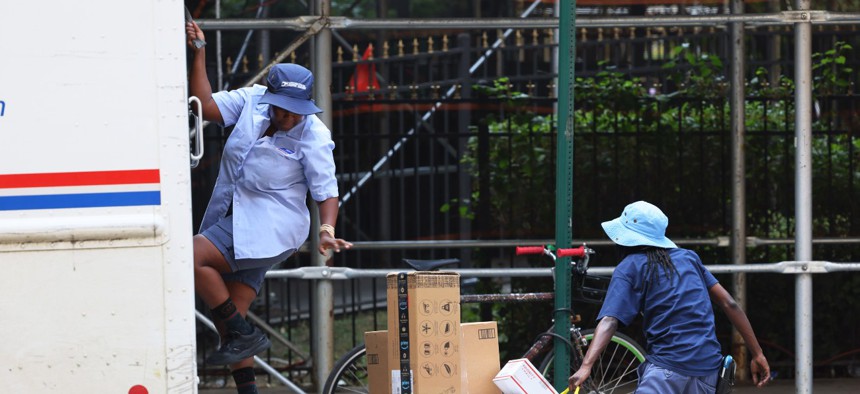
Mail delivery workers unload a truck on Flatbush Avenue July 22, 2022 in tBrooklyn. USPS piloted the initiative at a facility in Athens, Ga., in November, and the initial phase of the project is expected to impact hundreds of post offices. ichael M. Santiago/Getty Images
USPS Readies Employees for New Assignments Under Upcoming Consolidations
Letter carriers will not lose their jobs, but will have to relocate locally.
The U.S. Postal Service has informed employees of the details of their revised roles as they report to new facilities as soon as next month, when many letter carriers will have to commute significantly farther to make deliveries each day.
The conversions scheduled to take place in February are set to impact 17 post offices and other facilities in Florida, Massachusetts, New York and Texas, which will consolidate into five larger “sorting and delivery centers.” The moves are part of Postmaster General Louis DeJoy’s plan to remake the Postal Service’s network to reduce wasted movement and improve integration. USPS piloted the initiative at a facility in Athens, Ga., in November, and the initial phase of the project is expected to impact hundreds of post offices.
The changes will mean letter carriers no longer go to their local facility to pick up mail for their route, instead traveling farther distances after starting at a consolidated location. The impacted post offices will still conduct their retail operations, but a lot of the back-end functions will be stripped away and relocated.
Under an agreement with the National Association of Letter Carriers reached earlier this month, letter carriers are set to receive 60 days notice before being moved to another facility and will retain the seniority they have accrued. USPS will honor existing leave requests “except in emergency situations.”
USPS and NALC will meet 30 days before the consolidations to work out any differences in the working arrangement at the new location compared to the post office or facility at which the letter carriers used to report. Issues will escalate up the chain if they are not resolved at the local level. Management and the union will also meet to determine changes in how long it takes individual letter carriers to complete their deliveries, which could in turn impact their pay. Those estimates will be evaluated and adjusted, and any “auxiliary assistance” required will be provided accordingly.
Late last year, postal management informed employees in non-bargaining unit positions—such as those represented by United Postmasters and Managers—that the February implementation will not cause any dislocations for their positions. Postmasters reporting to an existing facility that will now be a sorting and delivery center could be in line for an automatic promotion. It has, however, implemented a hiring freeze for executive positions at impacted facilities “until we have an opportunity to discuss non-bargaining staffing with you.”
Clerks who report to post offices are expected to face a more minimal impact, though the exact effects are still being resolved. A spokesperson for American Postal Workers Union, which represents those workers, said the plans are under discussion but the union does not yet have a formal agreement.
Most post offices around the country operate as delivery units, meaning mail carriers go to them to pick up mail and packages for their routes before bringing them to homes and businesses. DeJoy has repeatedly decried this model, saying it is inefficient and can lead to as many as dozens of such units in one metropolitan area. Instead, he is looking to open sorting and delivery centers around the country, as well as larger mega-centers, that can take on more work in less space.
Under DeJoy’s plan, USPS is converting unused or dilapidated facilities to house the new facilities, or buying new ones to create the mega-centers. He has projected that process will lead to savings on contracted transportation, gas, real estate and time. There remain serious questions about whether his reforms will produce the savings DeJoy has promised, as previous efforts to consolidate facilities led USPS to perform worse while realizing just a tiny fraction of the cost reductions it had anticipated.
“The goal of this initiative is to make significant improvements to the delivery network to better serve the American public and our business customers more efficiently and effectively,” said Dave Partenheimer, a USPS spokesman. He added delivery routes will be “revamped” to make them “more efficient and cost effective.” Better equipment and improved layouts will also lead to more efficiencies, he said.
The next swath of conversions is set to take place in June and impact around three dozen facilities. One individual recently briefed on the plans by DeJoy directly said the chief executive speculated around 4,000 of the mailing agency’s 19,000 delivery units could eventually be impacted. Post offices and other facilities are only expected to consolidate their back end functions if they are within a 30 minute drive of the new center.







